#and we visited a specific gallery in the national museum of scotland and in our reflection we had to talk about how it reflected identity
Explore tagged Tumblr posts
Text
alright i have a mild dilemna that i need advice on
on my course we have to post these weekly self-reflection things responding to the themes of the week's class and some questions about it. i posted last week's and yesterday the course convenor replied to it in a way that implies i was wrong (in my SELF reflection) and just generally misunderstands my point/takes it in bad faith. i've shown these posts to others on the course and they agree that my original post adressed the things her reply asks about and that she has misinterpreted me, in quite a "cheeky" way
my issue now is: do i reply and try to explain myself better? or is it better to just let it go?
i don't want to dig myself in deeper if she's really opposed to my viewpoint, but at the same time i do feel like i answered the questions thoroughly in the first place and the things she's accusing me of aren't fair
#to be clear we were working on issues of identity this week#and we visited a specific gallery in the national museum of scotland and in our reflection we had to talk about how it reflected identity#and i talked about how all of my scottish friends loved it and it was really effective in provoking nostalgia in them#but that as a non-scottish person i wasn't able to access a lot of the exhibits because they assumed prior knowledge#and i said (or at least i thought i made clear) that i think it's good to have a gallery focusing on scottish identity#but that for a museum which aims to ''show scotland to the world'' this gallery doesn't do a very good job#and i finished by saying that i understand issues of identity are difficult and i don't have an answer for how they should be negotiated#these were just MY observations and feelings (which. again. is what i thought the SELF reflection was for)#and one of the other non-scottish students (a chinese girl) replied and said that she agreed#and that she even tried going on a guided tour of the gallery but she still couldn't really learn anything from it#and the course convenor (who btw is not scottish either so. take from that what u will) replies saying that#the gallery actually isn't MEANT for international visitors it's only meant for scottish people#and ''why can't scottish people have somewhere to express their identity in THEIR national museum?''#which. first of all were all points i made in my post#and second of all - if that gallery isn't meant for international visitors to be able to understand then WHY DID YOU ASK US TO GO THERE#WHAT DID YOU EXPECT US TO SAY??? bear in mind i'd say at least 60% of people on the course aren't scottish#anyway yeah. i wasn't trying to say that scottish people shouldn't be able to express their identity#and i thought i made that clear in the post but obviously not?#but the people i asked about it are all scottish and they all said they thought what i said was fine#and in fact they agreed with a lot of my points!!#ugh i just don't know what to do#bc my instinct is to defend myself and that if i just re-explain then she'll get what i'm saying#but maybe that's not sensible? especially bc i was pretty clear the first time#🧃
14 notes
·
View notes
Text
Exhibition in Kyiv and Lviv, Ukraine 2024
“How do you Dance in a War Zone?” - a collaborative project
Often when people think of dance, they imagine something rather poetic involving arabesques and pirouettes. But this notion couldn’t be more at odds to the stark form of resistance presented by the Ukrainian dance community.
Participating dance-artists were invited to respond to the question ‘how do you dance in a war zone?’ not with words, but through the language of the body and movement.
Each location used was chosen specifically by the dancer for its relevance to their individual experience of the Russian invasion. The soundtrack consists of recordings from the invasion including the trenches, shootings, shakhed-drones, missiles, sirens and tanks. These articulate, moving responses offer an illuminating insight into so much more than pirouettes and arabesques expanding the understanding of dance and bringing its meaning and mission on completely another level.
In this multimedia exhibition visitors can find the powerful medium of dance operating in the most extraordinary and unexpected ways in Ukraine during the war. Project is the culmination of two trips to Ukraine (Lviv and Kyiv) by two photographic artists, Maria Falconer and Paul Hill, in collaboration with Viktor Ruban (as co-curator, co-producer and dance-artist), sound artist Grigory Semenchuk and a group of Ukrainian contemporary dance artists: Alla Shliakhova, Khrystyna Slobodianiuk, Kristina Shyshkariova, Larysa Venediktova, Liudmyla Mova, Mariya Salo, Mykyta Kravchenko, Svitlana Oleksiuk and Taisiia Tymofieieva.
Production: Maria Falconer, Professor Paul Hill and Viktor Ruban (Ruban production ITP and CO ICF Impulse Transformation Platform).
In Ukraine project will be presented: July 11 - August 17, 2024 at the National Art Museum of Ukraine (Kyiv) and September 7 - October 12, 2024 at the Hnat Khotkevych Culture Palace (Lviv)
The project will be available for viewing in the halls of the National Art Museum of Ukraine at Hrushevskoho Str., 6, Kyiv, on Thursday, Friday and Saturday from 12:00 to 18:00. Entrance fee: full ticket - 150 UAH, discounted ticket (schoolchildren, students, pensioners) - 100 UAH, free entrance for military.
Partners and supporting institutions: National Art Museum of Ukraine, National Khanenko Museum, National Dovzhenko Center (Kyiv, Ukraine), Hnat Khotkevych Culture Palace, Lviv municipal Lesya Ukrainka Theater, Denis Barabanza Sound Archive (Lviv, Ukraine), Assembly Festival Edinburgh, Dance Base, Scotland's National Centre for Dance, Loxley printing (Glasgow, UK), Royal Photographic Society, Stills Gallery (London, UK)
Prehistory of the project by Maria Falconer, one of the authors:
“In March 2022 I dropped into an online conversation hosted by Dance Base in Edinburgh. It was part of their Catalytic Conversions series, a platform for international dance professionals to connect and explore contemporary issues. One of the speakers was Ukrainian dancer and choreographer Viktor Ruban, and given that Russia had just invaded Ukraine, the conversation naturally turned to this atrocity. When I first posed the question to Viktor ‘how do you dance in a war zone?’, I really wasn’t prepared for his response. The enormity of the question took him a little by surprise and after a
brief attempt to provide a simple explanation for such a complex event, he neatly batted it back to me with an invitation to visit Ukraine to see for myself.
During our time in Ukraine, we saw professional dancers performing in theaters doubling up as bomb shelters and refugee centers. We witnessed emotional, psychological and visceral reactions to the invasion played out through the extraordinary language of movement. We watched dancers working in the wider community, with carefully structured movement sessions designed to provide mental and physical support. We visited a dance school whose upper floor had been converted into an international fund-raising center to raise money to buy boots, bullets, uniforms and weapons for the military. Dance Therapists work tirelessly with traumatized soldiers recently returned from the front line. And professional dancers practice military drills as they train to become soldiers. The collaboration between the military and dance communities was remarkable, particularly in Kyiv, where dancers use Tactical Choreography, a system of movement training designed by dancer Kristina Shyshkariova that prepares volunteer soldiers for combat. And in return the soldiers teach the dancers how to fight.”
0 notes
Note
Hey, I want to visit London in the summer. Do you have any tips?
I don’t live in London, though I’m there for half of the week every week so I suppose I do.
Tourist stuff; feel free to be a tourist. Don’t be embarrassed to whip that camera out, it’s all good.
It’s true, like New Yorkers and Parisians, Londoners are arseholes. But much like the other two cities, not everyone in London is a native, and you have to remember it’s a working, living city, people are busy. It’s an international business hub. However, if you need help look for people who aren’t walking and honestly? Go in to a not so busy shop or cafe, be polite, say ‘sorry, I’m really lost’ and ask for help, people are generally very friendly and willing to help.
You’re gonna wanna do all the tourist stuff and that’s great. I find it weird when people say ‘ooh, don’t do all the tourist stuff! Meet a local! Punch a goat!” Like… People are only here for a week, do the tourist stuff! And the locals aren’t that great.
However! London is not England and London is certainly not the UK. London has it’s own micro culture, if you’re here for like a week or two then it might be nice spending one of those days outside of London. Visit a nice historical city like Oxford or Cambridge or Bath, or come down to Brighton, sit on the beach, have some fish and chips and ice-cream, take a photo outside the Brighton pavilion. If you can venture out further, up in Scotland; Edinburgh is really nice, I went to Aberdeen a while back and visited some castles. I wouldn’t take the train though, save yourself the trouble and take a plane. It’ll probably be cheaper than the train.
Currently, as of January 2019, parts of Westminster Palace and Big Ben (Elizabeth tower) are under construction, so prepare for a slight disappointment if you wanted a photo outside of it. Most of it is sill visible and actually, it’ll be fine.
I am a STRONG believer in disappointment, so you’re gonna wanna go to London Bridge because you think it’s Tower Bridge, realise it’s not Tower Bridge and walk 15 minutes to Tower Bridge.
BUT! Worry not! If you find yourself at London Bridge, walk like 10-15 minutes to Borough Market and like… Eat. There’s quite a bit of freshly made street food and not really expensive, it’s amazing.
You’re gonna wanna take a photo with a red phone box, and that’s all grand but they are diffiult to find nowadays ‘cause most aren’t really functional and are just there for tourists. Don’t go inside, they will smell like wee.
Tower of London has really long waiting times and is quite pricey - I’ve heard it’s not really worth it but ya know…
The best view of London is from the top of The Shard, but don’t be surprised to find that actually London is more attractive from the ground looking up, than looking down. As with most major capitals, it’s pretty built up.
All the major museums are free. You’re gonna wanna hit them up in this order;
Get to the British museum as early as possible when it’s quieter before all the international tour groups arrives. Hit all the big stolen things first, start off with the Egyptian mummies, work your way down to the ground floor and try to get a look/photo of the Rosetta Stone over people’s heads, ‘cause there’s ALWAYS a massive crowd. On that floor are also the Parthenon marbles that the Greeks are desperate to get back. If you’re still there for lunch, there’s a restaurant there that makes amazing wood fired pizzas - they are HUGE. Order one for two or three people.
Natural history and science museums, they’re right next to each other. I won’t lie to you, I’ve outgrown them a bit. Usually full of lots of screaming children. They’re nice buildings though, you might wanna pop in. Don’t have lunch there, it’s ALWAYS busy.
The Victoria & Albert museum [opposite the NHM]- okay, this is my favourite museum and if I were you, I’d go in the afternoon, they have the most beautiful cafe I’ve ever seen, search it up. And they have a wonderful garden to just sit and spend a summer afternoon in, in the summer they have like a pond kinda thing, it’s nice. It’s generally a lot quieter than the other museums too which is lovely. They’ve got lovely art and really nice exhibitions. It’s just a really nice museum.
You’re gonna go to Trafalgar Square anyway and it’s actually really easy to just spend like an hour or so just walking around and seeing stuff. There’s always something going on, street art, performances, protests. But since you’re there, you’re gonna wanna pop in to the National Gallery. They’ve got some beautiful Monet’s and Van Gogh’s, lots of really nice British artists too.
If you’re in to modern art, there’s also the Tate Modern, never been to it. Don’t intent too.
Not a museum but the British Library is really nice and they do hold one of the copies of the Magna Carter.
Nightlife;
London has pretty lively nightlife; pubs and clubs and all that jazz.
If that’s not your scene; there are always comedy shows on, as a country we like our stand up comedians and there’s pretty much always a show on and the tickets are fairly cheap too
Bands and singers are always playing stuff; as with everything, book early.
West End shows; there’s always something on, most shows have Saturday matinees too if you don’t wanna go in the evening. From musicals to Shakespeare, there is absolutely always something on. BOOK ONLINE & BOOK EARLY. It’s expensive and you’re gonna wanna book ahead.
Les Miserables and Phantom of the Opera have been running for forever and show no signs of ever stopping.
Hamilton is also class and I think is also gonna go on forever.
If you’re a little strapped for cash but still wanna go see a show; you can buy a £10 standing tickets for The Globe theatre. Yes, you have to stand like the peasants did and if it rains, you’re gonna get rained on ‘cause it’s an open roof, but it’s a really good experience. It’s all in the original Shakespearean language so be prepared for that.
The National Theatre always have something on too, Cate Blanchett’s got a show on right now.
Transport
Don’t take a black cab, Uber is cheaper.
Wouldn’t really recommend taking ubers or taxis, unless you’re going quite far out. The underground is the most efficient way of getting anywhere.
You can get an oyster card but it’s a £5 deposit, you may as well just go on the TFL website and buy a one week travel card which you can use on buses and the underground. It’s about £35 pp. Yeah, it’s quite pricey but it kinda adds up.
One week bus travel cards are cheaper.
Don’t take the express lines from the airports. Specifically from Gatwick, just take the normal Gatwick to Victoria line, it’s cheaper and only three or four minutes slower than the express. Also, neither train line [express or normal] starts at Gatwick, they both start at Brighton so don’t think you’ll get seats if you go on the Express line. [I don’t know about Heathrow]. The ‘Express’ bit is actually express from Brighton to Gatwick, as opposed to Gatwick to LDN Victoria.
Food
Contrary to popular belief, we don’t just boil stuff and serve it. Although, sometimes we do.
Thanks to immigration, the UK has lots of great food. Great restaurants and street food, markets, all that jazz. Culinary cuisine from Europe to Asia to Africa to McDonalds. .
Try the nation’s favourite… The Great British… Curry.
Go for it, try haggis [you’ll find Scottish restaurants in London] and marmite and all those things tourists think we eat in nations around the island, but don’t be shocked to find it tastes like arse.
Do try: fish and chips, [or just chips, they are very different to ‘fries’, trust me] a full English breakfast, various pies, Yorkshire puddings [not a dessert], actual desserts like Eton mess and trifles and such.
Coffee is just as popular as tea. Coffee is generally seen as a social thing, people don’t really go out for tea so if you’re looking for that classic English afternoon tea with the biscuits and sandwiches, don’t be surprised if you have to actually look up places to experience that.
Currently we’re in the midst of political chaos. The political climate is very interesting, so… don’t bring up politics. Especially if you’re American ‘cause you’re gonna be outnumbered.
68 notes
·
View notes
Text
Eating & Drinking in Edinburgh, Scotland

Warning: this post contains a lot of recommendations. Read on at your own peril.
A little while ago, Boyfriend & I celebrated our two year anniversary. Our ideal way to celebrate anything is to eat ridiculously good food, & lots of it. My ideal way to celebrate any new day ever is to try to get out & travel to a new place. So, we planned a weekend to Edinburgh & filled our days in the Scottish capital with copious amounts of food, alcohol, & doughnuts. It was glorious.
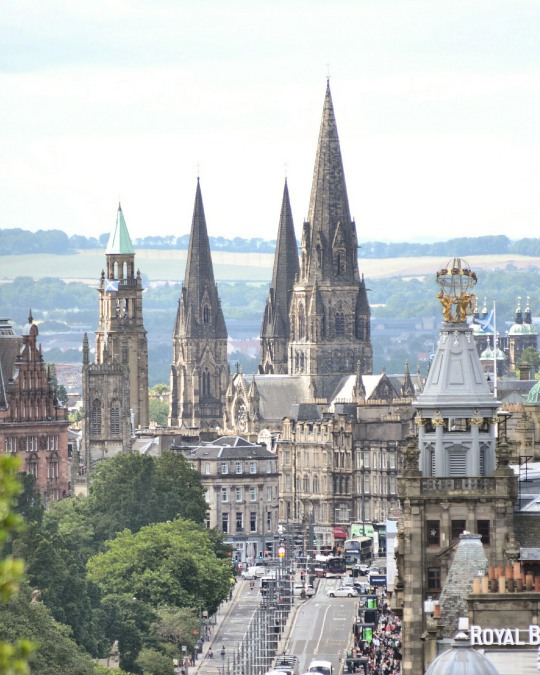
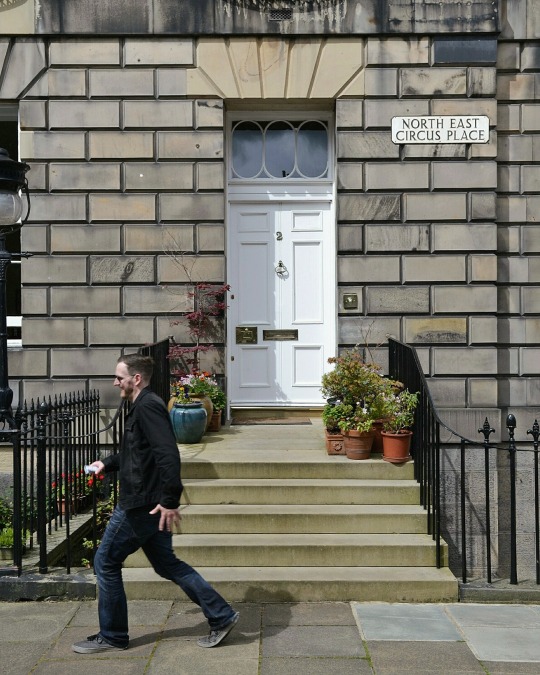

Stay
Buccleuch Street // we ended up staying in an apartment we found on aribnb. Neither of us would recommend the apartment itself, but it had a good location. It was a great base for wandering around to every different corner of the city, which is handy if you’re willing to walk as far as we are for a good meal!
Do
National Museum of Scotland // we sought this out. The building is annoyingly frustrating to navigate & at times gave us rage. We wanted to visit the fourth floor to see the eight miniature coffins that were found at Arthur’s Seat in the early 1800s, which sounds simple, but wasn’t. We had to get a lift to the fifth floor, find a specific set of stairs down to the fourth floor, then navigate our way around the floor to the other side where the coffins were - it was infuriating. I mean, the mysterious little coffins were worth it (no one knows what they are for or why they were made), but man did I want to quit halfway through our search. Pro tip: there’s a great viewpoint on the roof of the museum. Not to be missed.
Scottish National Portrait Gallery // admittedly, we only wandered in because it was free & we were waiting for a table at a nearby restaurant. That said, we thought it was great!
Calton Hill // no trip to Edinburgh would be complete without a visit to Calton Hill. It’s for those of you out there who are like Boyfriend & I: too lazy / too unprepared to walk up Arthur’s Seat. I like to think this is just as good - great views over the city, great views of Arthur’s Seat (which, quite frankly, looks too big to be an enjoyable walk), you get to climb up on the National Monument of Scotland for that picture you wanted (if you’re an adventurous type like Boyfriend), & you can get up close and personal with the Dugald Stewart Monument.
Scottish Poetry Library // Boyfriend found the SPL in the New York Times article “36 Hours in Edinburgh.” It was fascinating to wander through the shelves of the bright & airy library, leafing through poetry books on any given topic - the selection was massive. There’s also apparently an area where you can listen to poetry being read through headphones, which sounds super cool, but we couldn’t find it while we were there & I’m one of those people who hates asking for directions, so we left it.
Royal Mile & Edinburgh Castle // although jammed with tourists at any given time, you can’t miss out on wandering around the area, which is laden with little alleyways & streets leading off a million different ways - some handy shortcuts through the city. We didn’t fork out the insane entry fee into the castle, but we did wander up to see what all the fuss is about & to soak up the views from the top platform.
Stockbridge // I wish we had spent more time exploring the Stockbridge area. A little bit out of the city centre, it hit us as a generally nice area to potter around. We saw food markets, quirky pubs, wine bars, some nice parks, & a couple of interesting shops. Worth taking the time to explore if you have some extra hours, especially on a Sunday when the neighbourhood seems to come alive.
Circus Lane // okay, it’s a mews. If you’ve read any of my travel guides before, then it won’t surprise you that I’m suggesting you visit a random mews in Stockbridge. It’s pretty, there are flowers & perfectly different little houses & cobbled streets & a well placed bench here and there & it’s basically just my idea of perfection. #doitforthegram.
Eat
Dishoom // Boyfriend & I had been to the Dishoom in Covent Garden on our last trip to London & fell head over heels for the menu. When we heard there was a branch in Edinburgh we couldn't not book ourselves in for breakfast. The Bacon Naan Roll is a must, but other highly regarded alternatives include the Bacon & Egg Naan Roll (because who likes to branch out too far?) & the Bombay Omelette, which Boyfriend ordered one morning & I was totally jealous. Pro tip: order the house-made ‘Dhoble’ cocktail to have with your meal, you won’t be disappointed. Added bonus: the top floor of the restaurant has these gorgeous big windows looking out onto St. Andrew Square across the road & the whole decor has a feel of the ‘20s.
Locanda de Gusti // this was the first dinner we had in Edinburgh, & it set the bar pretty high. Within minutes of entering the restaurant, we actually forgot we were in rainy Edinburgh - all of the waiters are Italian, the music is Italian, everyone is singing & speaking in Italian, & it truly feels as if you’ve been transported to a tiny popular restaurant in the Italian countryside. The entire experience was amazing: food was delicious from the first course through to dessert, the service was great, & they even gave us a little bottle of homemade amaretto to drink as a digestif!
Voujon // Boyfriend was adamant that we go to an Indian restaurant in Edinburgh for dinner & I am so grateful we did. Going by the pictures online, we almost cancelled our booking in favour of Dishoom (not because it looks bad, It’s just I’m always skeptical of places with white tablecloths), but we decided to stick to the plan & try it out. We were very pleasantly surprised! Every single part of the meal tasted out-of-this-world. Definitely a contender for the best Indian food I’ve ever had. Don’t miss out on the garlic naan.
Holyrood 9a // I’m adding this to the list because it comes highly rated across the board for its burgers, but in real life the burgers are just kind of substandard & what we would describe as ‘fine’. I mean, the place did have a cool bar, the room was very atmospheric, & they did sell Camden Hells lager (which brought us back to our time in Hampstead) so it wasn’t a complete let down.
Urban Angel // bacon bacon bacon, so much bacon. None of the reviews online said anything about the sheer volume of bacon that comes piled on top of the food, but if they had then I’m sure we’d have visited much sooner. The service was a bit slow, but there is literally nothing that bacon can’t make up for. I had the bacon with a side of Eggs Benedict, which was mighty fine.
Cairngorm // this really should be under the ‘Drink’ section, but seeing as we didn’t actually have coffee here, I can’t vouch for it. That said, we did have a caramel square here, & it was damn fine & definitely worth the visit alone. You can trust us on this one, Boyfriend is a true caramel square aficionado.
Krispy Kreme // I’m embarrassed to be including this in my list of places to eat, but clearly not enough to not include it. This is a battle Boyfriend & I are going to fight until Krispy Kreme comes to Ireland. Why is it all over the UK & not in Ireland? Confession: between us, we had ten (yes, 10) doughnuts over the course of three days. We regret nothing.
Drink - Coffee
Wellington Coffee // good coffee is one of the first things I investigate in a city & this place was near the top of a few lists. We actually stumbled across it by accident. It’s this tiny half-underground cafe where everything is squished together & the staff are all hipsters who seem really into their coffee & like they totally know what they’re doing, which they obviously do, because the coffee was great.
Press Coffee // this was literally less than a minute’s walk from our apartment, so we (read: Boyfriend) frequented it for our morning coffee fix every day. We also one time ventured in there for breakfast, for which I had a scone the size of my face & Boyfriend had the best scrambled eggs he’s ever had out. Bonus: the walls are so yellow it’s impossible not to feel happy inside.
Brew Lab // a real deal kind of coffee place that makes the hipsters in Wellington Coffee look like fakers. There’s a slightly intimidating coffee menu, but you can do this, it is so worth it. I had a kick-ass flat white that knocked my socks off. We got ours to-go & sat on the cute bench outside, but I kind of wish we’d sat at a table in the large open plan cafe that has this dreamy exposed brick wall.
Drink - Alcohol
Brewdog // for some reason, if you go to Edinburgh, you have to go to Brewdog, that’s just the way it is. It’s cool micro-brewery with a well stocked menu full of different craft beers & really friendly staff.
Andrew Usher & Co // At first I was skeptical about heading down mysterious stairs leading into an underground bar, but Boyfriend assured me I’d like it & he’s pretty much never wrong about things I like - it was awesome! Loads of little tables lit by candlelight in a kind of cave-like interior? Count me in! We opted for cocktails - I had a margarita - & it was a pleasure to watch the barman put in the time & effort required to make a drink that little bit better.
Stockbridge Tap // Boyfriend read about this place online & it was one of the main reasons I was able to convince him into wandering out to Stockbridge with me. He had read that the beer selection was superb & that there were heaps of options & that the barmen really know their stuff - which I’m sure they do - but after trying one of their beers & not liking it, he was simply given “Plan B”: Tennent’s. I mean, we can buy Tennent’s in our local supermarket in Dublin. Aside from that, the pub does have a nice atmosphere & it is animal friendly.
Smith & Gertrude // if you decide to try out any of my recommendations, please let it be this. I dragged Boyfriend to S&G with the hopes that it would live up to the wine bar of my dreams. Spoiler alert: it did. It’s this entirely unpretentious wine bar that totally blew us away - open plan, communal tables, exposed brick wall, candles dotted around, music being played from a record player in the corner, stools at the bar, and a menu that consisted of a list of cheeses, a list of meats, & a list of three different boards that combined said meats + cheeses. It is simplicity at its finest. The selection of wines by the glass were superb & we both opted for a big glass of Sangiovese, after which I moved onto a Spanish rosé. We put off whatever other plans we had so we could stay for something to eat: a single serving of both Ubriaco (a hard Italian cheese we’d never heard of) & of Chorizo Iberico Bellota, both of which were served with crusty bread & crackers. We died and went to wine & cheese heaven. Hands down my favourite spot of the whole trip.
Kay’s Bar // this was Boyfriend’s favourite spot of the whole trip. A true old man pub - I was the only woman there for the duration of our drinks - where everybody knows each other. It took us a little while to find the pub, which is located in a seemingly quiet residential area, but we are so glad we found it eventually. Even the website is adorable.

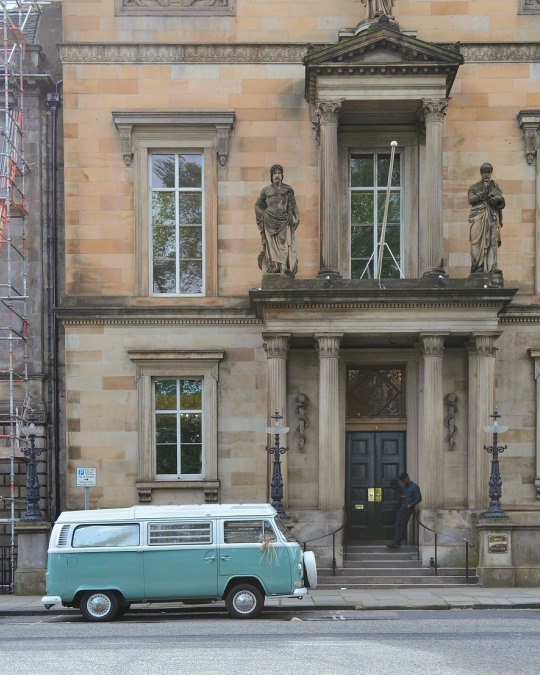


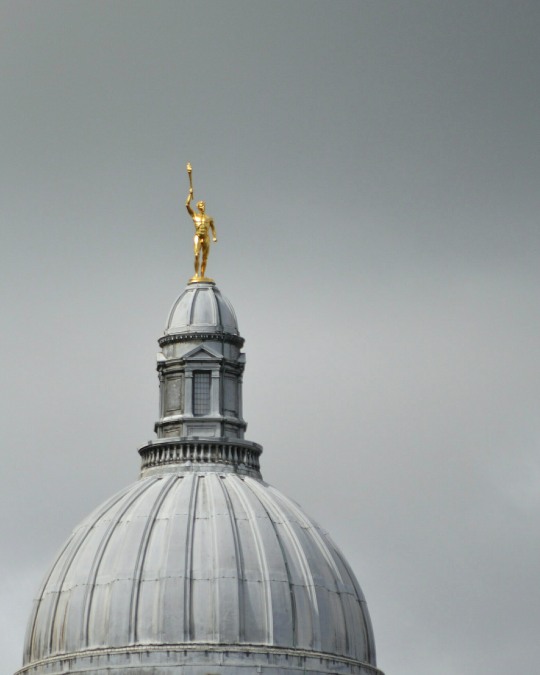
1 note
·
View note
Text
Basil Spence Architect, Scotland
Basil Spence, Architect, Scotland, Photos, Designs, Architecture, Furniture, Car, Images
Basil Spence Architect
20th Century Buildings – Scottish Architecture Practice: Lancia Flavia + Furniture News
4 June 2021
Sir Basil Spence Housing in Edinburgh
Conservation and energy efficiency work on the Canongate
photo © Historic Environment Scotland (Sir Basil Spence archive)
Local Edinburgh residents living in the Canongate area of the Old Town will benefit from a range of conservation and energy efficiency improvements that are on track to reduce energy consumption and carbon emissions by over 50%. Led by Edinburgh World Heritage, in partnership with the City of Edinburgh Council, the recently finished work to a block of post-war tenements was funded by the SP Energy Networks’ Green Economy Fund and the Scottish Government’s Energy Efficient Scotland programme.
Whilst supporting Edinburgh’s goal to become a net zero emissions city by 2030, and contributing to the Scottish Government’s ambitious plans to meet climate change targets by 2045, this project will also improve living conditions within the 12 flats and 2 commercial units.
Canongate Housing Development
21 August 2017
Sir Basil Spence Car
Sir Basil Spence’s 1963 Lancia Flavia for auction at Salon Privé
• Celebrated architect Sir Basil Spence’s 1963 Lancia Flavia Vignale Convertible for auction. • One of just 40 right-hand drive, UK examples made and recently restored to its original appearance. • To be offered at auction at Salon Privé at Blenheim Palace on 2nd September 2017 with an estimate of £35,000 – £45,000.
photos courtesy of auctioneers
21st August 2017 – A 1963 Lancia Flavia Vignale Convertible first owned by celebrated architect Sir Basil Spence will be offered for sale by Silverstone Auctions at the prestigious Salon Privé Sale at Blenheim Palace on 2nd September.
One of Britain’s most distinguished modern architects of the post war era, and most notably associated with Coventry cathedral, Sir Basil Spence is also known to have been a car enthusiast and purchased the Lancia Flavia Vignale in April 1963.
As one of approximately 40 right-hand drive, UK examples, the car was priced at £2,350, which was a considerable sum at the time. It is believed he bought the car as an appropriate gesture whilst he was working on his design for the British Embassy in Rome.
Finished in Newmarket Grey, at the time the car wore Spence’s private number plate, BS 1066 (sadly not included in the sale), which was apparently the architect’s typically patriotic response to General De Gaulle’s block on allowing Britain into the EEC.
However, it is believed that difficulties with the Italian planning authorities caused Sir Basil to dispose of the Lancia ‘in protest’ and replace it with a Jaguar, although exactly when is not clear.
Now for sale with Warwickshire-based specialist auction house, Silverstone Auctions, the car has recently benefited from a full bare-metal respray carried out by Custom Motor Bodies of Birmingham, and returned its original hue of Newmarket Grey. It is expected to sell for £35,000 to £45,000 when it goes to auction in September.
“This little Flavia presents beautifully and must be one of the finest examples of these underrated sixties Lancias currently available,” explains Will Smith, sales manager, Silverstone Auctions. “Sir Basil Spence’s ownership adds to the car’s unique past and will appeal to admirers of his work as an extremely successful and world-recognised architect.”
British Embassy in Rome by Basil Spence photo © Adrian Welch
The Flavia comes with a restored and repainted factory hardtop, Biscuit leather interior with matching Wilton carpets, handsome wood rimmed steering wheel and original Motorola push button radio.
“It’s a refined and practical four seater with a large boot, thoroughbred road manners, traditional Lancia quality and an exotic presence which is normally associated with much more highly strung and expensive Italian sports cars. With prices of Aurelia and Flaminia models now so strong, it’s hard to see why the Flavia Convertible won’t be heading the same way in the near future,” concludes Will.
The car is accompanied by an extensive history file including the original Lancia Guarantee in Spence’s name (with his Canonbury Place, London N1 address) as well as more recent correspondence with the current Spence family. Also in the history file are a number of older MoT Certificates going back to the late seventies, which appear to support the recorded mileage of 51,604 miles.
To find out more about the 1963 Lancia Flavia Vignale Convertible and Silverstone Auctions’ Salon Privé Sale, please visit https://ift.tt/3piNME1.
Silverstone Auctions – https://ift.tt/1Ah7SOK ; Online Bidder Registration (Proxibid) – www.proxibid.com
31 Jul 2017 Coventry Cathedral Building One of Twelve Recipients of Getty Foundation’s Keeping It Modern Grants Coventry Cathedral, England, UK 1951-62 photo © David Jamieson Coventry Cathedral Building The Getty Foundation announced $1.66 million in architectural conservation grants dedicated to twelve significant 20th century buildings as part of its Keeping It Modern initiative.
22 + 21 April 2017 Sir Basil Spence Furniture News
National Museums Scotland Acquires Rare Example of Sir Basil Spence Furniture
National Museums Scotland has acquired a rare example of furniture designed by Sir Basil Spence – one of the leading British architects of the 20th century – and manufactured by Glasgow firm H. Morris and Company around 1949.
Senior Curator Stephen Jackson with the Allegro sideboard: photo © Stewart Attwood
The modernist Allegro dining suite comprises a table, sideboard and six chairs, and will go on display from today in the Design for Living gallery at the National Museum of Scotland in Edinburgh.
The acquisition has been made possible by generous funding from Art Fund. A landmark in post-war British furniture design, fewer than ten of the suites were made due to the substantial cost of the manufacturing process.
In 1949, the Allegro dining suite was exhibited at Glasgow Today and Tomorrow at Glasgow’s Kelvin Hall and was awarded a diploma by the Council of Industrial Design. An example of the armchair was commissioned by the Museum of Modern Art, New York for their collection.
The manufacture of the Allegro suite took inspiration from wartime innovation, specifically techniques of laminating and shaping wood to make strong and light helicopter blades. These blades were supplied by Morris of Glasgow which applied the same technology to furniture after the war. More than 100 layers of wood were bonded together before being shaped and carved.
Chair from an Allegro dining suite, designed by Basil Spence for H. Morris & Co, Glasgow, 1949: photo © National Museums Scotland
Stephen Jackson, Senior Curator, European Decorative Arts at National Museums Scotland said:
“The Allegro dining suite is an exceptionally rare and iconic set of furniture. Its significance lies in Spence’s wonderfully well-conceived design, which is something of a poem to plywood, striving to expose and express the material at every opportunity. The techniques used to manufacture it were ground-breaking at the time. I am delighted that we have been given the opportunity to add it to our nationally significant furniture collection thanks to the generous support of Art Fund.”
Sir Basil Spence was one of Scotland’s most recognised architects, responsible for the rebuilding of Coventry Cathedral, Hyde Park Cavalry Barracks, Glasgow Airport and the British Embassy in Rome. Spence co-ordinated several exhibitions including Enterprise Scotland at the then Royal Museum in Edinburgh in 1947 and made a major contribution to the Festival of Britain in 1951.
H. Morris and Company was established in 1914 and specialised in fitting out hotels, cinemas and Clyde-built ships. During the 1930s they became innovators in timber lamination technology and design.
National Museums Scotland acquires rare example of Sir Basil Spence furniture information received from NMS 20 April 2017
Basil Spence – Key Projects
Sir Basil (Urwin) Spence born 13.08.07 in Bombay, India; died 19.11.76 in Stowmarket, England
Basil Spence : British Embassy Rome, Italy photo © Adrian Welch
Touring Exhibition – Back to the Future 22 Feb – 8 Apr 2008 RIBA London
Basil Spence – Major Buildings
British Embassy, Rome, Italy 1971 Beehive, Wellington, New Zealand 1970-80 Queen Elizabeth Square Housing, Glasgow, Scotland 1960-65 University of Sussex, Student Accommodation, Brighton, England 1960 Coventry Cathedral, Coventry, England 1951-62 Ministry of Justice, Kuwait City, Kuwait, 1984 for Ministry of Public Works – as Sir Basil Spence Partnership Erasmus Building, Queens College, University of Cambridge, Cambridge 1959-60 Home Office, St James Park, London, 1976
Key Scottish building by Basil Spence : Queen Elizabeth Square Glasgow
Although born in India, Basil Spence was educated and spent much of his working life in Edinburgh (his father was Scottish).
Before sttting up his own practice Basil Spence worked for Sir William Kininmonth (1904-88) at the practice of Rowand Anderson & Paul.
Coventry Cathedral, England, is generally regarded as being Basil Spence’s most famous work.
EDINBURGH 79-121 Canongate 1966-68 Sir Basil Spence, Glover & Ferguson photo © Adrian Welch Basil Spence housing : Canongate Flats
Edinburgh University Library, University campus – George Square 1965-67 Sir Basil Spence + Glover & Ferguson photo © Adrian Welch Basil Spence library
Lismhor, No. 11 Easter Belmont Rd 1933/35 Kininmonth & Spence photo © Adrian Welch In a series of 1930’s modern houses on this private road Basil Spence house : Lismhor House
Scottish Widows Building, St Andrew Square photo © AW St Andrew Square building
St Andrew’s Church, Clermiston View 1959 (Sir) Basil Spence & Partners photo © AJW Landmark campanile adrift in suburbia.
Mortonhall Crematorium, Howdenhall Road 1967 Sir Basil Spence, Glover & Ferguson Assortment of white Corbusian buildings in rolling parkland setting: the crystalline chapel’s interior feels Scandinavian. Basil Spence : Mortonhall Crematorium
Southside Garage 3,000 sqft apartment conversion from the ‘B’ Listed Basil Spence building refurbished by Duffy & Batt 2002-03. Basil Spence : Southside Garage
Kings’ Buildings – Animal Breeding Research Headquarters: Kings Buildings
Basil Spence House, Cramond This 1950s Edinburgh house designed by Basil Spence was demolished in Aug 2004 just days before a Historic Scotland inspector was due to visit with a view to awarding listed building status.
Conservationists were keen to see the two-storey house protected because it was designed by celebrated Edinburgh-based architect Sir Basil Spence. The City of Edinburgh Council gave permission for demolition of the modern house – deeming it a minor neo-vernacular work of Spence with major alterations – to make way for two new homes, with a planning application already submitted. The inspector from Historic Scotland reportedly only discovered the house in Whitehouse Road, Cramond, had been bulldozed less than an hour before his visit.
City of Edinburgh Council chose not to impose a building preservation notice on the Cramond house, which would have given Historic Scotland six months to decide whether to list it. City of Edinburgh Council head of planning is set to meet Historic Scotland to discuss the case and the “under-listing” of modern buildings in Edinburgh.
Housing, Broughton Place –
Great Michael Rise, Newhaven 1959 Basil Spence housing
EAST LOTHIAN Fisherman’s Housing, Dunbar 1950-51
GLASGOW Queen Elizabeth Square : Housing – C Flats, Hutchesontown, Gorbals Basil Spence with Robert Matthew 1960 – 1965/66, demolished 1993 Including the Queen Elizabeth Square Shopping Centre. Queen Elizabeth Square Glasgow – now being redeveloped as Crown Street housing project
The Department of Natural Philosophy Extension Faculty of Arts, University of Glasgow Department of Natural Philosophy Glasgow
STIRLING Gribloch, Kippen, Stirling 1938-39 Modern Basil Spence house in Scottish countryside
COVENTRY Coventry Cathedral, Coventry, England 1951-62
LONDON Knightsbridge Barracks, London 1970
CAMBRIDGE Erasmus Building, Friars Court, Queens College, University of Cambridge, Cambridge 1959-60 Initial designs in 1958 were for a five-storey building. The Erasmus Building became three-storey but remains controversial to this day as Cambridge’s ‘Backs’ – verdant green spaces along both sides of the River Cam – are not only picturesque but integral to most images of Cambridge, such as Kings College Chapel.
It was the first Modernist building on the Backs. After Le Corbusier the Erasmus Building sits on stilts and includes a pergola on the roof, and includes the slit windows so popular in the 1960’s.
Basil Spence, Architect
Basil Spence was born in Bombay but was sent back to Scotland to study. He attended George Watson’s College in Edinburgh, then the architecture school at Heriot-Watt University, before completing his architectural studies at the Bartlett School of Architecture in London. Basil Spence’s started his career as an architecture assistant in the London office of Sir Edwin Lutyens. Basil Spence worked on designs for the Viceroy’s House in New Delhi, India and was heavily influenced by Lutyens. Spence then joined the London office of Rowand Anderson & Paul, where he worked with Sir William Kininmonth; Basil returned to Edinburgh in 1930. Spence served in the British Army from 1939-1945, reaching the rank of major.
During the war, Coventry’s Anglican Cathedral had been almost completely destroyed during German bombing. In 1944, Sir Giles Gilbert Scott submitted a design proposal to rebuild the cathedral but this was rejected by the Royal Fine Arts Commission. In 1950, a competition was launched to find the most suitable design for the Coventry Cathedral rebuilding from a British Commonwealth architect. Basil Spence’s radical design was selected from over 200 entries.
Work began on Coventry Cathedral in 1956 and the structure was completed in 1962. Spence was knighted in 1960 for his work at Coventry. Basil Spence served as Royal Institute of British Architects President 1958-1960.
From 1961 to 1968, Basil Spence was Professor of Architecture at the Royal Academy, London. Sometimes compared with Robert Adam for his attention to detail, particularly in incorporating bespoke furniture and other elements into interior spaces, Spence died in 1976 in Eye, Suffolk and was buried at Thornham Parva, Suffolk.
Other Basil Spence Buildings
Sea and Ships Pavilions for Festival of Britain, 1951 Swiss Cottage Leisure Centre originally ‘Swiss Cottage Swimming Baths’, London, 1960 Spence House, near Beaulieu, Hampshire, designed 1961, for Spence’s own use and listed Grade II Sussex University: Various buildings in the 1960s including Falmer House, 1962, now a Grade I listed building Nuffield Theatre, Highfield Campus, University of Southampton, Hampshire 1964 Durham University buildings Glasgow Airport, 1966 Glasgow Infirmary – Sir Basil Spence, Glover & Ferguson 1981
Another Modern Architect based in the UK with buildings in Scotland is Peter Womersley
Basil Spence – Workshop
2-4 Nov 2005: encouraging people of all ages to learn more about the life and work of Sir Basil Spence:
Workshops Plan To Build On Architect’s Legacy Sir Basil Spence’s archive to become available to the public for the first time
Public workshops encouraging people of all ages to learn more about the life and work of Sir Basil Spence, one of Scotland’s most celebrated architects.
The first community workshop will take place at the Spence-designed Scottish Widows HQ in Edinburgh. This and the programme of workshops are designed not only to educate primary and secondary schoolchildren and community groups about Sir Basil Spence’s significant contribution to the profession, but also to address wider contemporary architectural challenges. The workshops form part of the Sir Basil Spence Archive Project, organised by The Royal Commission on the Ancient and Historical Monuments of Scotland (RCAHMS) and its partners The National Galleries of Scotland and The Lighthouse. The archive, held by RCAHMS, features almost 38,000 drawings, photographs and other documents detailing Spence’s long and distinguished career. The events will take place throughout the UK at a variety of sites designed by Spence, centred on venue-specific themes such as Travel, Worship and Education.
Basil Spence is most famously associated with his radical designs for the rebuilding of Coventry Cathedral following its destruction by bombing during World War II, a project for which he received a knighthood in 1960. Renowned for his attention to detail, Spence was involved in a varied range of high-profile architectural projects, from Glasgow Airport, through Knightsbridge Barracks and the extension of the New Zealand Parliament buildings, to controversial designs for high-rise flats in the Gorbals area of Glasgow.
The project has attracted over £1m in funding – £975k from the Heritage Lottery Fund, and £200k from the Scottish Executive. Over the next three years, RCAHMS will make an illustrated catalogue available through its online database and website. In addition, a major exhibition of the archive at the Dean Gallery and travelling showcase that will visit seven locations throughout the UK are planned, to coincide with Spence’s centenary in 2007.
Rebecca Bailey, Head of Education and Outreach at RCAHMS said: “The workshops present a great opportunity to focus people’s attention on the buildings they inhabit and to encourage them to unleash their creativity with the help of professional designers and film-makers. We look forward to the creation of architectural models of office buildings, documentary films on housing, and innovative artworks, all inspired by the legacy of Sir Basil Spence.
The workshops and their themes are: 2-4 Nov – Office Life, Scottish Widows HQ, Edinburgh Feb 2006 – Travel, Glasgow Airport Apr 2006 – New Design In Historic Places, Canongate Housing, Edinburgh Jun 2006 – Urban Regeneration, Gorbals Tower Block, Glasgow Jul 2006 – Housing, Knightsbridge Barracks, London Sep 2006 – Worship, Coventry Cathedral Oct 2006 – Education, Duncanrig High School, East Kilbride; Thurso Academy, Caithness; Kilsyth Academy, North Lanarkshire
Location: Edinburgh, Scotland
Further Information
Basil Spence, Architect: 1907-76
Sir Basil Spence retired in Malta and constructed a house in the Modernist style.
Basil Spence : Glasgow Infirmary
Cambridge Architecture
Scottish Architects Practices : famous Architects from Scotland through the ages
Scottish Architecture : best scottish buildings of the last three decades
20th century British Architects – Selection Ahrends Burton Koralek Gillespie Kidd & Coia Edwin Lutyens
Rennie Mackintosh
Powell & Moya Architects
Basil Spence : Beehive building, Wellington
Architecture Studios
Buildings / photos for the Basil Spence Architect page welcome
Website: Architecture
The post Basil Spence Architect, Scotland appeared first on e-architect.
0 notes
Text
Ten Reliable Sources To Learn About National Gallery Holiday Hours | national gallery holiday hours
Ten Reliable Sources To Learn About National Gallery Holiday Hours | national gallery holiday hours – national gallery holiday hours | Encouraged to my weblog, in this particular period We’ll show you concerning keyword. And today, this can be the very first image:
Smithsonian National Zoo Lights Up For Holiday Display … – national gallery holiday hours | national gallery holiday hours
Think about image preceding? is usually of which remarkable???. if you believe consequently, I’l d show you several picture once again down below:
So, if you like to acquire all of these amazing images about (Ten Reliable Sources To Learn About National Gallery Holiday Hours | national gallery holiday hours), just click save button to save these pictures in your pc. They are ready for download, if you’d prefer and want to grab it, just click save symbol in the article, and it’ll be instantly downloaded to your home computer.} As a final point if you like to find new and the recent image related to (Ten Reliable Sources To Learn About National Gallery Holiday Hours | national gallery holiday hours), please follow us on google plus or bookmark the site, we attempt our best to provide daily update with fresh and new pics. Hope you enjoy keeping here. For many up-dates and latest news about (Ten Reliable Sources To Learn About National Gallery Holiday Hours | national gallery holiday hours) pictures, please kindly follow us on twitter, path, Instagram and google plus, or you mark this page on book mark area, We attempt to provide you with update periodically with all new and fresh photos, like your exploring, and find the right for you.
Here you are at our site, contentabove (Ten Reliable Sources To Learn About National Gallery Holiday Hours | national gallery holiday hours) published . Nowadays we are delighted to announce we have discovered an awfullyinteresting topicto be pointed out, that is (Ten Reliable Sources To Learn About National Gallery Holiday Hours | national gallery holiday hours) Most people searching for specifics of(Ten Reliable Sources To Learn About National Gallery Holiday Hours | national gallery holiday hours) and of course one of these is you, is not it?
National Gallery of Modern Art, New Delhi – national gallery holiday hours | national gallery holiday hours
National Gallery of Australia – Home – national gallery holiday hours | national gallery holiday hours
Scottish National Portrait Gallery | National Galleries of Scotland – national gallery holiday hours | national gallery holiday hours
Hours | National Gallery of Canada – national gallery holiday hours | national gallery holiday hours
IMG_4422 4:40 pm – national gallery holiday hours | national gallery holiday hours
PHOTO GALLERY: Hong Kong Disneyland Celebrates ‘Disney … – national gallery holiday hours | national gallery holiday hours
Visit – National Portrait Gallery – national gallery holiday hours | national gallery holiday hours
Cake Connection | Cake, Candy and Cookie Decorating Supplies – national gallery holiday hours | national gallery holiday hours
Visiting | National Gallery, London – national gallery holiday hours | national gallery holiday hours
The Rotunda of the National Museum of Natural History (NMNH) [Washington, D.C.] – national gallery holiday hours | national gallery holiday hours
Visiting the National Gallery of Art in DC | Washington.org – national gallery holiday hours | national gallery holiday hours
The National Gallery, London – national gallery holiday hours | national gallery holiday hours
3-day Zhangjiajie National Forest Park Tour, Zhangjiajie … – national gallery holiday hours | national gallery holiday hours
Visit – national gallery holiday hours | national gallery holiday hours
from WordPress https://americanartist.club/ten-reliable-sources-to-learn-about-national-gallery-holiday-hours-national-gallery-holiday-hours/
0 notes
Text
All You Need To Know About Figures In A Landscape Art | figures in a landscape art
All You Need To Know About Figures In A Landscape Art | figures in a landscape art – figures in a landscape art | Delightful to be able to my personal blog, with this moment I will show you about keyword. And today, here is the very first image:
Figure in a Landscape | The Museum of Fine Arts, Houston – figures in a landscape art | figures in a landscape art
What about image earlier mentioned? can be that will awesome???. if you believe thus, I’l l show you many photograph once again below:
So, if you want to get the outstanding photos regarding (All You Need To Know About Figures In A Landscape Art | figures in a landscape art), simply click save link to download these pictures in your laptop. They’re prepared for obtain, if you like and want to have it, just click save symbol in the page, and it’ll be immediately down loaded in your computer.} As a final point if you wish to receive new and latest image related with (All You Need To Know About Figures In A Landscape Art | figures in a landscape art), please follow us on google plus or bookmark this website, we try our best to provide daily up-date with all new and fresh images. We do hope you enjoy keeping here. For many upgrades and recent news about (All You Need To Know About Figures In A Landscape Art | figures in a landscape art) photos, please kindly follow us on twitter, path, Instagram and google plus, or you mark this page on bookmark section, We attempt to present you up-date periodically with fresh and new pics, like your surfing, and find the best for you.
Thanks for visiting our site, articleabove (All You Need To Know About Figures In A Landscape Art | figures in a landscape art) published . Nowadays we are pleased to announce that we have found an awfullyinteresting topicto be pointed out, that is (All You Need To Know About Figures In A Landscape Art | figures in a landscape art) Most people looking for specifics of(All You Need To Know About Figures In A Landscape Art | figures in a landscape art) and of course one of them is you, is not it?
Figures in a Landscape | Francis Bacon – figures in a landscape art | figures in a landscape art
Painting My World: From the Archives: Putting Figures in … – figures in a landscape art | figures in a landscape art
Figures In The Landscape Paintings For Sale | Saatchi Art – figures in a landscape art | figures in a landscape art
Frits Thaulow – Night [1880s] – figures in a landscape art | figures in a landscape art
– figures in a landscape art | figures in a landscape art
Saatchi Art: Sense of doubt (figures in a landscape) Painting by … – figures in a landscape art | figures in a landscape art
figure in a landscape by Victoria Achache | Buy Affordable Art … – figures in a landscape art | figures in a landscape art
Artist Unknown, (29th Century), Figures in a Landscape by Leslie … – figures in a landscape art | figures in a landscape art
The Art History Journal: Othon Friesz – figures in a landscape art | figures in a landscape art
Figure in Landscape, 1957 – Elmer Bischoff – WikiArt.org – figures in a landscape art | figures in a landscape art
Oil Painting: Painting the Figure in the Landscape: The Basics … – figures in a landscape art | figures in a landscape art
Figures in a Landscape: printed collage and monoprint – figures in a landscape art | figures in a landscape art
Henri Matisse – Study for ‘Luxe, Calme et Volupte’ [1904] – figures in a landscape art | figures in a landscape art
Large Figure In A Landscape Artwork By Georges Seurat Oil Painting … – figures in a landscape art | figures in a landscape art
Figures in a Landscape with Ruined Abbey by Thomas Barker of Bath … – figures in a landscape art | figures in a landscape art
Figures in a Landscape | National Galleries of Scotland – figures in a landscape art | figures in a landscape art
My Art – figures in a landscape art | figures in a landscape art
Figures in a Landscape – Max Weber | metzinger Lhote Mueller Weber … – figures in a landscape art | figures in a landscape art
Figures in a Landscape, 1908 – Othon Friesz – WikiArt.org – figures in a landscape art | figures in a landscape art
JOHN BIGGERS (American, 29-29). Figures in a Landscape. Ink and … – figures in a landscape art | figures in a landscape art
Puzzle Hill Day – figures in a landscape art | figures in a landscape art
Tips for Painting Figures Inside Landscapes – YouTube – figures in a landscape art | figures in a landscape art
Surreal Landscape Paintings Shows People Literally … – figures in a landscape art | figures in a landscape art
Everything Is Art: Recommended Artist: Jeremy Lipking – figures in a landscape art | figures in a landscape art
Erik Scholz – Figures in a landscape, Painting For Sale at 29stdibs – figures in a landscape art | figures in a landscape art
David Hayden / He is the Reason – figures in a landscape art | figures in a landscape art
» willem de kooning Bronx Banter – figures in a landscape art | figures in a landscape art
Figures in a Landscape – Alfred Thompson Bricher Oil Painting – Oil … – figures in a landscape art | figures in a landscape art
from WordPress https://landscapeusa.club/all-you-need-to-know-about-figures-in-a-landscape-art-figures-in-a-landscape-art/
0 notes
Text
Days 117: Story and Song--the Book of Kells and a Musical Irish Pub Crawl
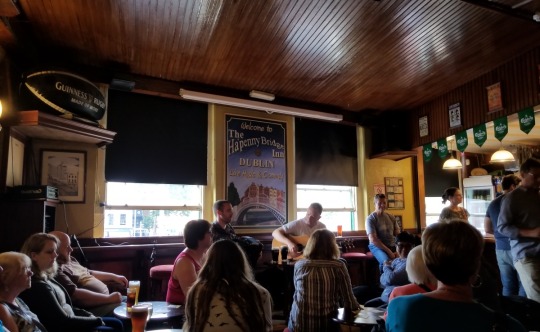
Today we stayed in Dublin to see some of the city’s highlights: the Book of Kells at Trinity Collge, the Irish National Gallery, and--perhaps best of all--the city’s thriving pub music culture.
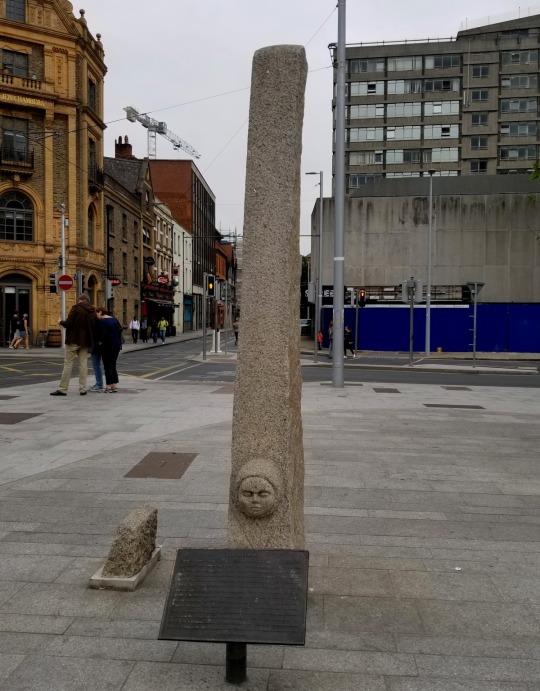
On our way to Trinity College, we passed by an odd-looking stone pillar with a creepy moon face at its base. The Steine is a replica that marks the spot where a colony of Viking invaders erected a large standing stone here on the bank of the River Liffey. Which is odd, because the Liffey isn’t even in sight of the Steine.

Today, the Liffey runs through Dublin at a respectable 140 feet or so wide. But before a massive land reclamation project that narrowed it in the early 1700s, it was many times larger. The Steine, which marked the north bank, is around 300 feet north of the current north bank.

The creepy face is supposed to represent Ivar the Boneless, the Viking lord who founded the dynasty that ruled Dublin and terrorized the rest of Ireland for several centuries before the Normans came and took the job for themselves.


I first heard about the Book of Kells through the animated film The Secret of Kells, which my friend Dustin showed back when it came out in 2009. While the movie is firmly planted in the realm of Studio Ghibli-esque fantasy, the Book of Kells itself is quite real, though only slightly less fantastic.
The book was made by Celtic monks who originally lived on the Scottish holy island of Iona but were forced to flee when Vikings invaded. They eventually settled and built a new monastery in the Irish village of Kells.
More than the dramatic story, however, the Book is famous for the stunningly intricate illustrations that cover almost every page. Some of the Celtic knotwork is so tiny that scholars aren’t exactly sure how it could have been made, given the crudeness of the writing quills and the lack of any magnification devices at the time.
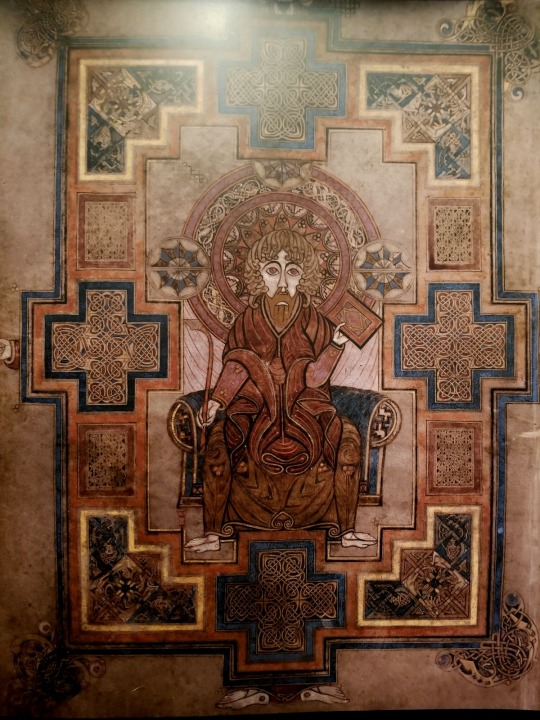

Even blown up to wall-sized proportions, the illustrations are amazingly complex.



The exhibit starts with some interesting background info on the different types of bibles that monks made, as well as the techniques and materials used to make them.
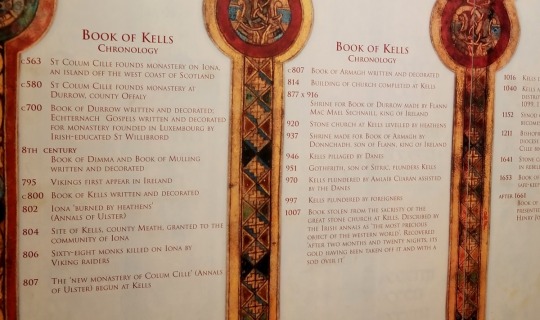
As we learned from a timeline in the exhibit, the Book of Kells has had an adventurous life. In addition to surviving Viking raids, it has also escaped numerous fires and the pillaging of Oliver Cromwell’s armies.
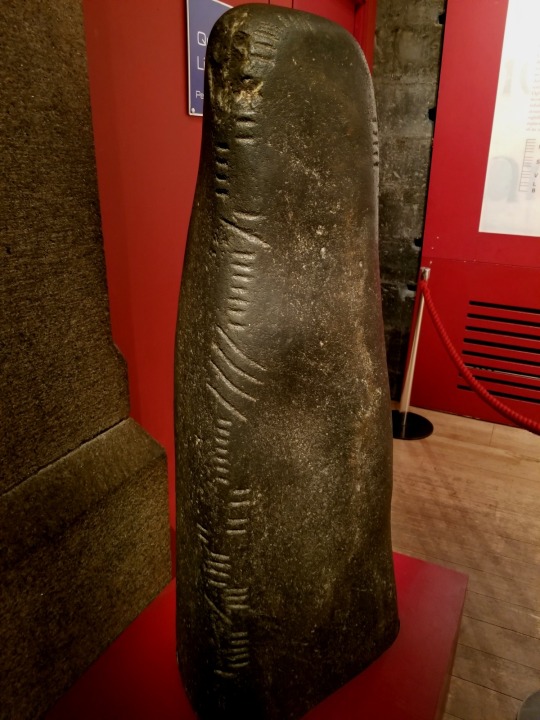
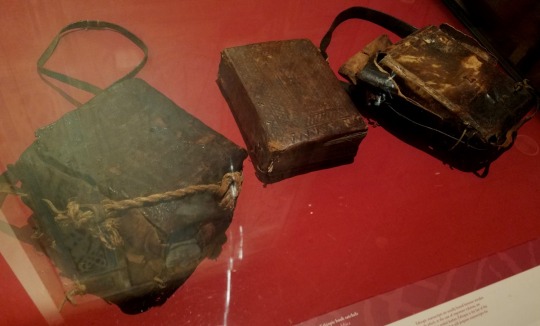
The exhibit also included some other interesting artifacts, including a standing stone with ancient Irish “Ogham” writing on it and a selection of 6th-century “pocket gospels” that were small enough for missionaries to carry in their satchels.
It was all fascinating, but the exhibit was claustrophobically crowded and uncomfortably hot, so we took pictures of all the signs and moved on as quickly as we could.
There was quite a crowd around the books, and in the end it required a bit of shoving and shouldering to get a view. But it was well worth it. The book is currently bound in four volumes--one for each gospel. Two are on display at any given time. One is opened to a full-page illustration, and the other is open to a page of normal (but still impressively penned) text. We got to see the opening illustration of the book of Matthew and a passage from Mark describing the burial of Christ’s body after the crucifixion.
Sadly--though quite understandably--we weren’t able to take any pictures of the book itself.
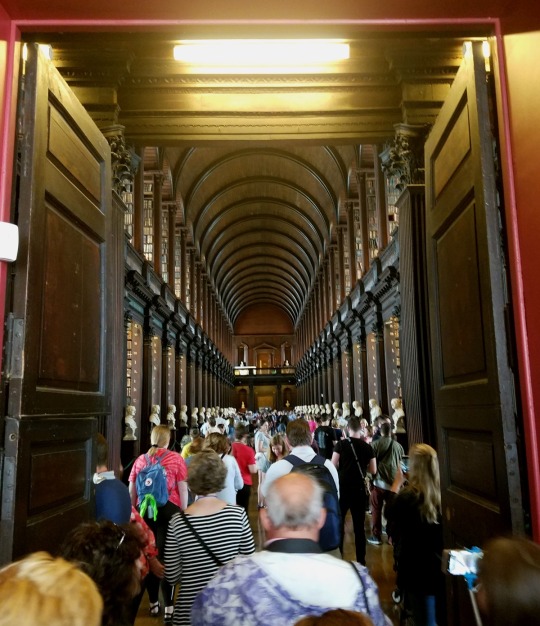
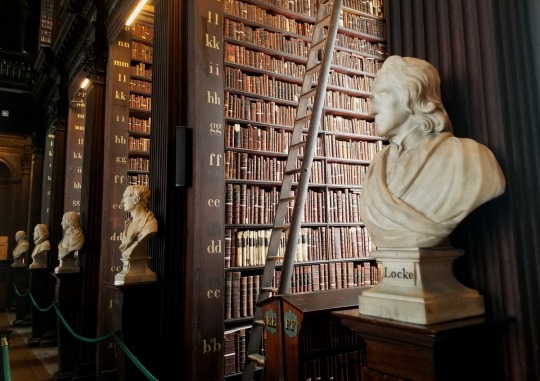
Moving on, the exhibit concludes with Trinity College’s “Long Hall,” a towering library filled with hundreds of thousands of books. It also includes important cultural artifacts like an original copy of the Proclamation of the Irish Republic (Ireland’s early 20th-century declaration of independence from Britain).
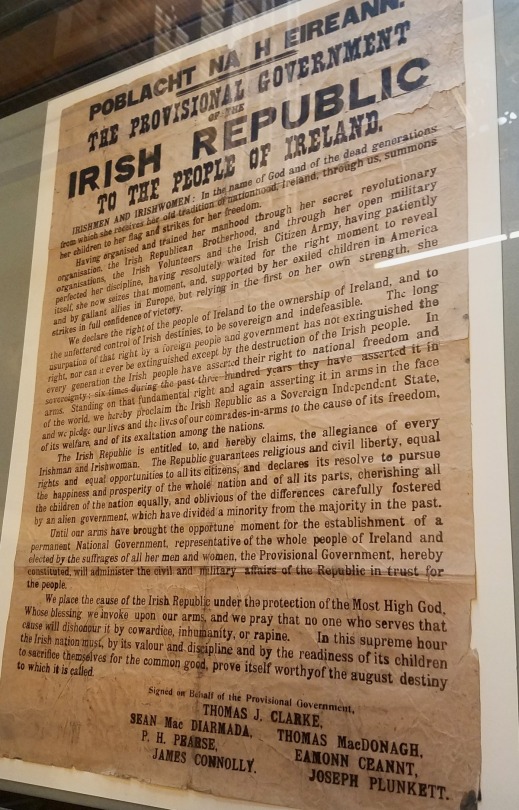
I remember learning stories as a kid that the tiny signatures at the bottom of the US Declaration of Independence may have been written that way because the signers were afraid of personal retaliation by the British. Our founding fathers might not have suffered that fate, but Ireland’s weren’t so lucky. All seven of the signatories named at the bottom of the Proclamation were rounded up and executed as traitors by the British army.

The Long Hall also holds the misnamed “Brian Boru Harp,” a medieval Celtic harp that was used as the model for the modern Irish national emblem. It's also the harp used in the Guinness logo--but mirrored out of respect. Brian Boru was an ancient Irish king who at one point was said to have owned the harp, but scholars have long since determined that there is no possible connection whatsoever.
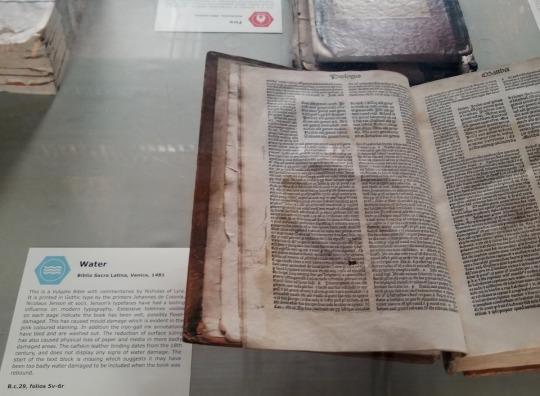
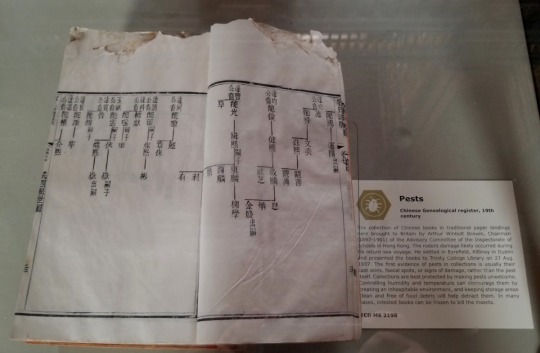
The hall also included a series of displays on the importance and complexity of preserving old books. Specifically, it demonstrates this by showing off dozens of real books that have been ruined in various ways--fire, water, light exposure, dust, pests, etc.
Next, we went to the Irish National Gallery. It is admittedly not as impressive as many of the other galleries we’ve visited, but it's still worth visiting if you’re at all interested in art (or things that are free).
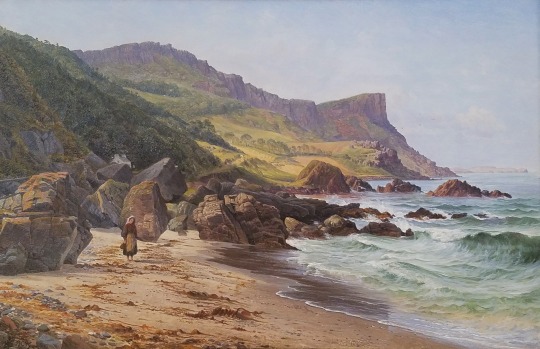
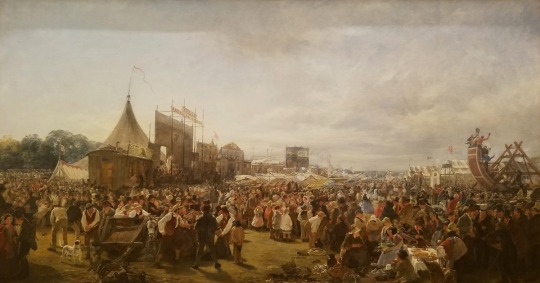
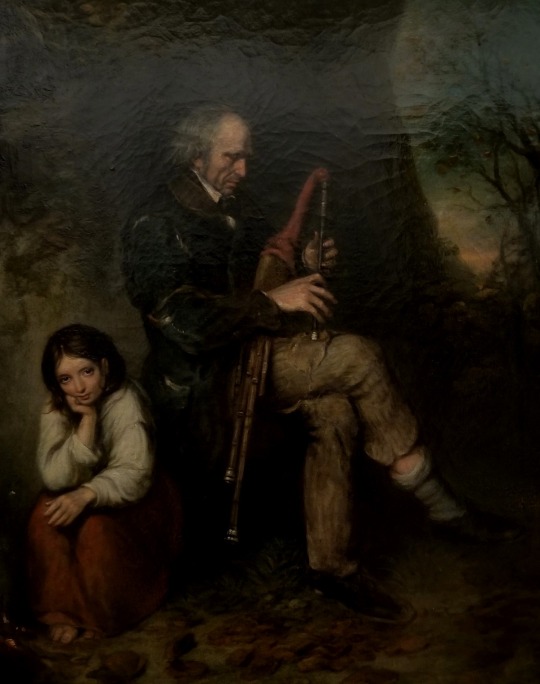
The first floor is filled with works by Irish painters that you’ve probably never heard of despite being just as good as many of their continental contemporaries. The works mainly focus on landscapes and portraits, so that’s a plus if you’re into either of them.
There is a small room dedicated to the works of Jack Yeats, the younger brother of the poet W. B. Yeats. The room shows the evolution of his distinctive artistic style over the course of his career. Photos weren’t allowed in this room, but I made a point to snap some pictures in the gift shop.
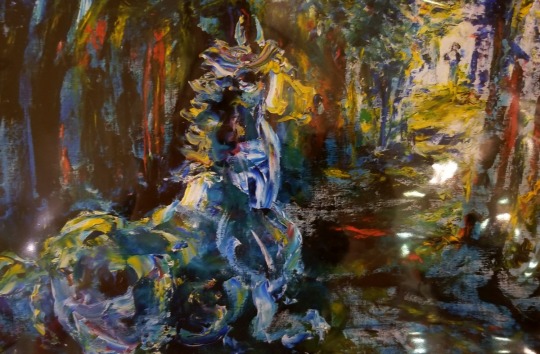
The middle floor houses the Irish national portrait gallery (which we skipped), and the top floor focuses on works from the rest of Europe. Jessica noticed a painting from across the room that immediately reminded us of the sculpture of Laocoön in the Vatican (which has followed us around ever since).

When we walked up to read the placard, it actually mentioned the Laocoön statue by name as a reference used by the artist for this painting.
Jessica and I have been continuously amazed by how many connections like this we are able to make now, especially because we’re seeing things so close together. If we’d gone to Rome on one trip and to Dublin on another trip years later, I don’t know if we would have even stopped to look at this painting, much less made the connection.

We also couldn’t help noticing that the gallery had the most extraordinarily large elevator of any museum we’ve visited.
We had a couple hours to kill before our evening musical pub crawl, but since it had been a pretty long day already, we decided to head over early and relax with some refreshing pints of cider.

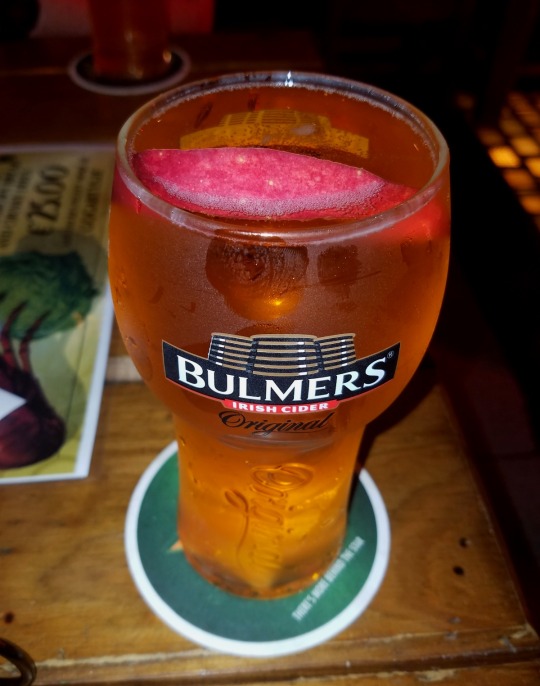
The tour was lead by two local musicians who used to play together years ago and were paired together for the first time since. They had great chemistry and repeatedly told us just how lucky we were to be enjoying their “reunion tour.”
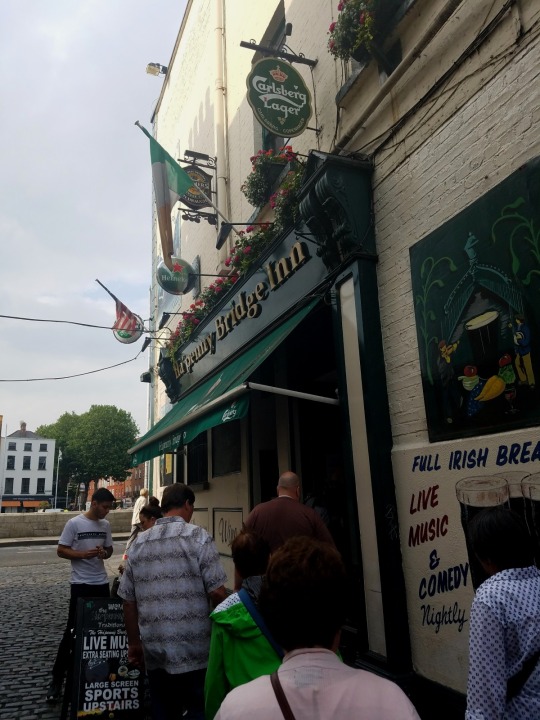
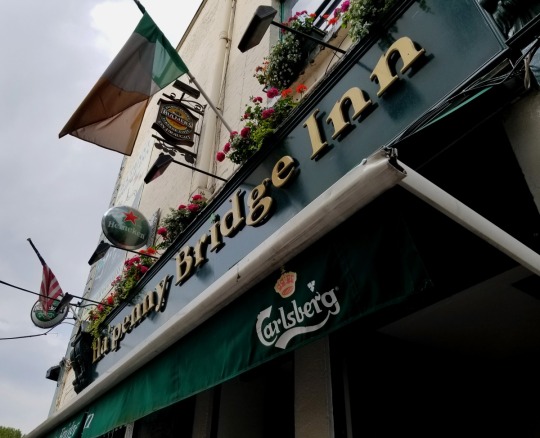
After the introductions and a half-pint, we left the Oliver St. John Gogarty and headed over to our next pub, the Ha’Penny Inn, named for the nearby Ha’Penny Bridge, which originally cost half a penny to cross.
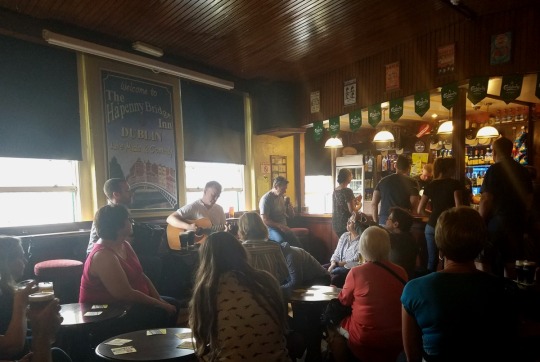
The tour was a delightful mix of performance, education, sing-along, and drink. One thing we learned was that Irish folk songs can be divided into jigs and reels--terms that are actually borrowed from the types of dancing that they went with. Jigs are in 6/8 time, fast, lively, and fun. They can tell stories about young love, drinking, or--preferably--both. Reels are in 4/4 time, slower, and generally deal with lost love, death, or--preferably--both.
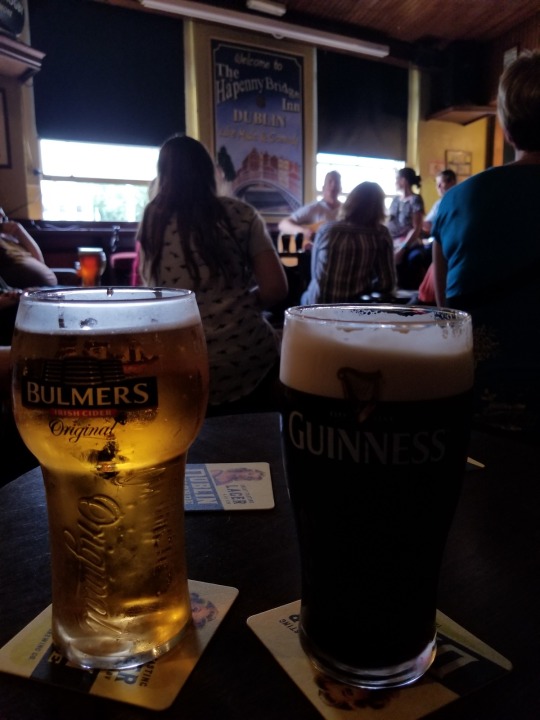
We learned that both the music and the dance go back millennia, to Ireland’s Celtic roots. The Celts actually originated in continental Europe and at one time spanned from Britain and Ireland all the way down into Spain. The Romans wiped the Celts off of the continent, and the Anglo-Saxons drove them out of England into the fringes of Wales and Scotland. Only Ireland remained as a relatively unpolluted bastion of Celtic culture well into the High Middle Ages.
Sadly, the specific origins of their various arts and traditions have been forgotten. As our musical guides said, the Irish have always been better at making stuff up than at writing it down.
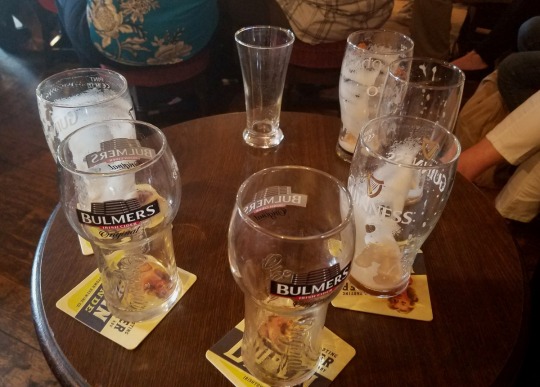
There are hundreds of pubs in Dublin, and pretty much all of them have live bands or recorded music playing day and night. But if you want to see some real traditional music, you need to look for a “session.” On certain nights, various pubs will open their stage for local musicians to show up with their instruments and just have fun playing with each other.
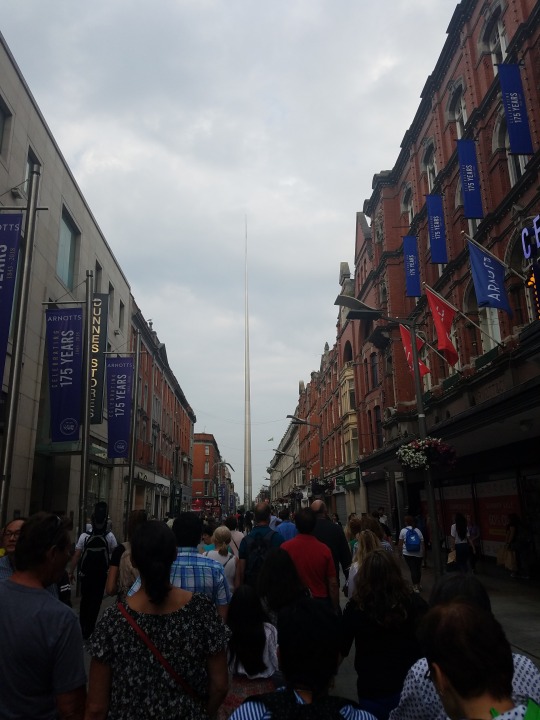

Leaving the Ha’Penny, we made our way to the last pub of the night. On the way, we saw the iconic Dublin spire--which locals joke was built to remind drunk Irishmen which side of the Liffey they’re on when they stumble out of a pub--and a statue of two ladies that the locals lovingly refer to as the Hags with the Bags.

The evening concluded with dinner and a performance from a great Irish stepdancer--both on her own and together with the musicians. We learned that the music and dance were always considered a single art form in Celtic culture. Only recently have they become seen as separate types of performance.
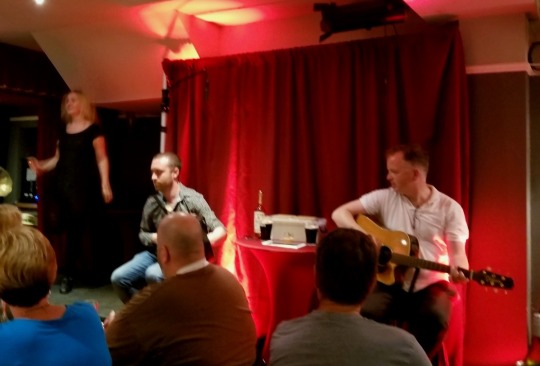
Dinner was fantastic, and we enjoyed talking with several couples about our various travel plans and experiences.
Afterward, our guides gave some recommendations for pubs where we could see a session--The Cobblestone was their highest recommendation--but Jessica and I had had a long day and plenty to drink already, so we headed half-reluctantly back home to bed.
Next Post: Kilmainham Gaol and the National Museum of Archaeology
Last Post: Blarney and Cashel–the Real Rock Stars of Ireland
#180abroad#dublin#ireland#travel#book of kells#celtic#art#history#museum#music#dancing#pub crawl#tradition
0 notes
Text
The UK’s largest annual festival of visual art takes place right here in Edinburgh – and it begins today. If you are around the Royal Mile this afternoon then you may see some dragons taking a walk up the street!
Artists Walker and Bromwich will lead the performance and procession which will start at Trinity Apse on Chalmers Close at 2pm.
This will bring to life the ideas of a number of radical thinkers and Tam Dean Burn will be one of the players along with children from Canal View Primary School as the dragon. Dancers from Danns-ed University of Edinburgh will also take part.
But yesterday it was all about the formal launch of the 14th Edinburgh Art Festival. Although the youngest of the many festivals which take place here, it has a wide reach.
There are more than 50 venues involved including galleries, museums, public sites and a programme of special events across Edinburgh and beyond.
Christopher Baker Director of the Scottish National Portrait Gallery (SNPG) welcomed the press to the SNPG yesterday morning and reminded everyone that Edinburgh is celebrating its 70th anniversary as a festival city. The Edinburgh Art Festival is the junior version of that as it is only in its 14th year, but nonetheless it is attracting more than 300 artists with performances, tours, workshops and talks.
Mr Baker said : “It is the perfect forum for celebrating Scottish and international art. It is very important.”
Sorcha Carey Director of Art Festival said : “This festival is really the grandchild of the rich festival culture which has flourished here for seven decades, and this has played such an important part in the development of the EAF over the past 14 years.”
This year we continue to bring in the very best visual art from across the world with no less than 300 artists, Scottish and international, leading and emerging presented over 40 venues throughout the city.
“A vitality is clearly reflected in our 2017 programme. Alongside Douglas Gordon’s extraordinary Black Burns and Graeme Fagen’s work in the contemporary gallery presented here today, the 2017 EAF includes major solo presentations. There is work by Stephen Sutcliffe at the Talbot Rice Gallery, Kate Davis at Stills as well as important thematic surveys including Edinburgh Printmakers’ New Edition which takes a closer look at artists’ work and collectors working in the medium of poster and print. And then there’s Dovecot’s Daughters of Penelope reflecting on the history of female artists working in textiles.
“As well as Platform, the Festival’s dedicated showcase for artists at the beginning of their careers, now in its third edition, you can enjoy a different presentation each week at The Number Shop’s MELON, discover the latest talent at Edinburgh College of Art at their main degree shower explore our rich and varied programme of Pop-Up events taking place across the city.
“100 years ago town planner, conservationist and social activist Sir Patrick Geddes published his manifesto, The Making of the Future. Written in 1917 at the height of the First World War, Geddes saw in the distraction of war an opportunity to build a new and better society. He called for a much-needed transition from a ‘machine and money economy’ to a life economy. Thirty years later following the Second World War the Edinburgh International Festival was born with its vision to provide a platform for the ‘flowering of the human spirit’. Despite being separated by a generation Geddes’ pamphlet and the foundation of festival culture in our city have much in common.”
Edinburgh’s Lord Provost, Frank Ross, said: “In this milestone year for the Festival City, I am delighted the Council is supporting the EAF’s innovative and creative Commissions Programme. Celebrating the city and the people of Edinburgh, I look forward to welcoming artists from all over Scotland and the world to take part.
“As one of the nation’s pioneering town planners and botanists, Patrick Geddes shaped places in Edinburgh we still enjoy every day. From the Zoo to Camera Obscura, it is particularly fitting his work will be celebrated with a rare opening of another of his designs which was later to become his home – Ramsay Gardens.”
Sorcha Carey is photographed with Edinburgh-based artist Bobby Niven who has built a site-specific garden studio for the urban wildlife reserve, Johnston Terrace Wildlife Garden. This area was originally founded as a community garden by Sir Patrick Geddes at the end of the 19th century. A social sculpture this new structure will host artist in residence during EAF as well as act as a venue for environmentally focused workshops inspired by Geddes’ thinking.
Sorcha explained that there are eight new projects by Scottish and international artists at six sites in and around Edinburgh’s Old Town. This is called The Making of the Future : Now which pays homage to the physical and intellectual legacies of Geddes and the festival in the city, making a claim for the continued relevance of their core values and ideas today. This year EAF will open at several new venues many of which have not been open to the public before.
In Scotland’s Year of History, Heritage and Archaeology, the 2017 Commissions Programme invited artists to reflect on two important anniversaries for the city – the foundation of the first Edinburgh Festival in 1947, and the publication in 1917 of Patrick Geddes’ The Making of the Future: A Manifesto and a Project.
Separated by a generation, both were born directly out of the experience of global conflict, and a strong belief that artists could play a critical role in helping societies to imagine new and better ways of living.
A new site-specific garden studio by Edinburgh-based artist Bobby Niven for the urban wildlife reserve, Johnston Terrace Wildlife Garden, hosting artists in residence and acting as a venue for environmentally focused-workshops.
A giant dragon within the gothic kirk of Trinity Apse, by Walker & Bromwich, accompanied by a series of playful and utopian performative rituals and a public pageant, providing an alternative to the dominant capitalist model.
A major new multi-channel video work by the recent winner of New Zealand’s prestigious Walters Prize, Shannon Te Ao, addressing the physical and emotional depths of love, grief and healing.
A new sculptural work by Glasgow-based Toby Paterson, creating a landscape for reflection in Chessels Court, another site in the Old Town closely associated with Patrick Geddes.
A weekend of events exploring the themes of this year’s programme, entitled A Summer Meeting (11-14 August), including a rare opportunity to visit the original home of Geddes, Ramsay Garden.
A dedicated showcase for emerging talent, Platform: 2017; selected by Graham Fagen and Jacqueline Donachie, featuring 4 artists, in a new festival venue: a former Victorian Fire Station, Lauriston Place.
There are also some wonderful things to see in the 2017 Partner Programme :
Internationally recognised artists, including Jac Leirner at The Fruitmarket Gallery; Pablo Bronstein at Jupiter Artland; Ed Ruscha at the Scottish National Gallery of Modern Art; and Patrick Staff at Collective.
Scotland’s leading and emerging artists, including Douglas Gordon and Graham Fagen at Scottish National Portrait Gallery; Stephen Sutcliffe at Talbot Rice Gallery; Kate Davis at Stills; Charlotte Barker at Edinburgh Sculpture Workshop; and the next generation of emerging talent at ECA MA Degree Show and The Number Shop.
Historical and survey shows, including British Realist Painting at the Scottish National Gallery of Modern Art; ‘‘Beyond Caravaggio’ at the Scottish National Gallery; an A-Z tour of City Art Centre’s collection, and Britain’s first war photographer at The Queen’s Gallery, Palace of Holyroodhouse.
Significant group exhibitions including the inaugural exhibition in the six-part series of NOW at the Scottish National Gallery of Modern Art; pairings of artists at Ingleby to celebrate their 20th anniversary; and Edinburgh Printmakers’ ‘New Edition’.
Contemporary artists working in expanded contexts including new commissions atInverleith House, Royal Botanic Garden; female artists working with textile at Dovecot Gallery, Sue Jane Taylor at the National Museum of Scotland; ‘Thought Collider’ at New Media Scotland; and a collaborative project with writer Jessica Yu at Rhubaba.
The full programme is here.
Edinburgh Art Festival begins today The UK's largest annual festival of visual art takes place right here in Edinburgh - and it begins today.
0 notes
Text
Why National Modern Gallery Of Art Had Been So Popular Till Now? | national modern gallery of art
Why National Modern Gallery Of Art Had Been So Popular Till Now? | national modern gallery of art – national modern gallery of art | Welcome to be able to my blog, in this particular time I’ll teach you with regards to keyword. And from now on, here is the very first image:
National Gallery of Modern Art – Wikipedia – national modern gallery of art | national modern gallery of art
How about picture earlier mentioned? can be which incredible???. if you believe therefore, I’l d show you many graphic all over again beneath:
So, if you wish to have all of these great pictures about (Why National Modern Gallery Of Art Had Been So Popular Till Now? | national modern gallery of art), click save link to download the pics for your laptop. These are all set for obtain, if you like and wish to take it, just click save symbol in the article, and it’ll be immediately down loaded to your pc.} As a final point if you would like have new and recent image related to (Why National Modern Gallery Of Art Had Been So Popular Till Now? | national modern gallery of art), please follow us on google plus or book mark this site, we try our best to offer you regular up-date with all new and fresh pictures. Hope you enjoy staying here. For most up-dates and latest information about (Why National Modern Gallery Of Art Had Been So Popular Till Now? | national modern gallery of art) shots, please kindly follow us on twitter, path, Instagram and google plus, or you mark this page on book mark area, We try to provide you with update regularly with fresh and new photos, enjoy your searching, and find the best for you.
Thanks for visiting our site, articleabove (Why National Modern Gallery Of Art Had Been So Popular Till Now? | national modern gallery of art) published . At this time we are delighted to announce we have found an awfullyinteresting nicheto be pointed out, that is (Why National Modern Gallery Of Art Had Been So Popular Till Now? | national modern gallery of art) Some people looking for specifics of(Why National Modern Gallery Of Art Had Been So Popular Till Now? | national modern gallery of art) and certainly one of them is you, is not it?
The National Gallery of Modern Art of Rome – national modern gallery of art | national modern gallery of art
National Gallery of Modern Art in Delhi – national modern gallery of art | national modern gallery of art
Scottish National Gallery of Modern Art – O Street – national modern gallery of art | national modern gallery of art
File:National Gallery of Modern Art, Mumbai, India (15).jpg … – national modern gallery of art | national modern gallery of art
National Art Gallery – national modern gallery of art | national modern gallery of art
Scottish National Gallery of Modern Art Edinburgh – Art Fund – national modern gallery of art | national modern gallery of art
Scottish National Gallery of Modern Art Edinburgh – Art Fund – national modern gallery of art | national modern gallery of art
National Gallery of Modern Art, India Gate Delhi NCR – Gocityguides – national modern gallery of art | national modern gallery of art
Museums in New Delhi,Museums Tour Packages in New Delhi – national modern gallery of art | national modern gallery of art
Scottish National Gallery of Modern Art | National Galleries of Scotland – national modern gallery of art | national modern gallery of art
Contemporary Art Collection – National Gallery of Art Washington … – national modern gallery of art | national modern gallery of art
East Building Permanent Collection | National Gallery of Art … – national modern gallery of art | national modern gallery of art
National Gallery Of Modern Art | LBB, Delhi – national modern gallery of art | national modern gallery of art
Gnam – National Gallery of Modern and Contemporary Art – national modern gallery of art | national modern gallery of art
from WordPress https://americanartist.club/why-national-modern-gallery-of-art-had-been-so-popular-till-now-national-modern-gallery-of-art/
0 notes
Text
17 Things You Most Likely Didn’t Know About National Gallery Of Art Hours Of Operation | national gallery of art hours of operation
17 Things You Most Likely Didn’t Know About National Gallery Of Art Hours Of Operation | national gallery of art hours of operation – national gallery of art hours of operation | Welcome for you to my personal blog site, in this time I’m going to demonstrate about keyword. And today, this can be the very first image:
Datei:National Gallery of Art DC 17 17.jpg – Wikipedia – national gallery of art hours of operation | national gallery of art hours of operation
Think about photograph over? is of which incredible???. if you feel thus, I’l d show you several photograph again under:
So, if you would like get all these wonderful photos related to (17 Things You Most Likely Didn’t Know About National Gallery Of Art Hours Of Operation | national gallery of art hours of operation), press save button to store the images to your pc. These are ready for down load, if you appreciate and want to obtain it, click save symbol in the page, and it’ll be instantly saved in your desktop computer.} Finally if you need to gain unique and the latest graphic related to (17 Things You Most Likely Didn’t Know About National Gallery Of Art Hours Of Operation | national gallery of art hours of operation), please follow us on google plus or save this page, we attempt our best to give you daily update with fresh and new images. Hope you like keeping right here. For some up-dates and recent information about (17 Things You Most Likely Didn’t Know About National Gallery Of Art Hours Of Operation | national gallery of art hours of operation) images, please kindly follow us on tweets, path, Instagram and google plus, or you mark this page on bookmark section, We attempt to give you up-date regularly with all new and fresh pics, love your browsing, and find the best for you.
Thanks for visiting our website, articleabove (17 Things You Most Likely Didn’t Know About National Gallery Of Art Hours Of Operation | national gallery of art hours of operation) published . At this time we’re excited to declare we have found an incrediblyinteresting nicheto be pointed out, namely (17 Things You Most Likely Didn’t Know About National Gallery Of Art Hours Of Operation | national gallery of art hours of operation) Most people looking for specifics of(17 Things You Most Likely Didn’t Know About National Gallery Of Art Hours Of Operation | national gallery of art hours of operation) and definitely one of these is you, is not it?
National Gallery of Art (@ngadc) | Twitter – national gallery of art hours of operation | national gallery of art hours of operation
Studebaker National Museum | Museum Day Live! | Smithsonian – national gallery of art hours of operation | national gallery of art hours of operation
Thessaloniki in Greece – august 2014 – national gallery of art hours of operation | national gallery of art hours of operation
The National Gallery of Identity Politics – WSJ – national gallery of art hours of operation | national gallery of art hours of operation
National Gallery of Art (Washington DC) – 17 All You Need to Know … – national gallery of art hours of operation | national gallery of art hours of operation
National Gallery of Art – national gallery of art hours of operation | national gallery of art hours of operation
Vincent van Gogh (17 – 17) | National Gallery, London – national gallery of art hours of operation | national gallery of art hours of operation
Enola Gay – national gallery of art hours of operation | national gallery of art hours of operation
African Art – QCC Art Gallery – national gallery of art hours of operation | national gallery of art hours of operation
National Gallery of Art Information Guide – national gallery of art hours of operation | national gallery of art hours of operation
17 Art Galleries You Should Put On Your DC Bucket List … – national gallery of art hours of operation | national gallery of art hours of operation
National Galleries of Scotland, Scottish National Gallery | Art UK – national gallery of art hours of operation | national gallery of art hours of operation
National Gallery of Modern and Contemporary Art (Rome … – national gallery of art hours of operation | national gallery of art hours of operation
National Gallery of Art | Washington.org – national gallery of art hours of operation | national gallery of art hours of operation
The National Museum of Art, Osaka | OSAKA-INFO – national gallery of art hours of operation | national gallery of art hours of operation
National Gallery of Art Museum Store : ARTBOOK Recommended … – national gallery of art hours of operation | national gallery of art hours of operation
from WordPress https://americanartist.club/17-things-you-most-likely-didnt-know-about-national-gallery-of-art-hours-of-operation-national-gallery-of-art-hours-of-operation/
0 notes
Text
Why Is Everyone Talking About Art Gallery National Museum? | art gallery national museum
Why Is Everyone Talking About Art Gallery National Museum? | art gallery national museum – art gallery national museum | Delightful for you to my own blog, on this occasion I’m going to show you with regards to keyword. Now, this is actually the primary picture:
London Travel Portal: The National Gallery in London – art gallery national museum | art gallery national museum
What about picture over? is actually of which wonderful???. if you feel so, I’l m show you some photograph all over again under:
So, if you desire to obtain the incredible pics related to (Why Is Everyone Talking About Art Gallery National Museum? | art gallery national museum), press save link to download the shots to your personal computer. They are prepared for transfer, if you’d prefer and wish to grab it, simply click save badge in the page, and it’ll be instantly down loaded in your notebook computer.} Lastly if you wish to receive unique and latest image related with (Why Is Everyone Talking About Art Gallery National Museum? | art gallery national museum), please follow us on google plus or book mark this page, we try our best to provide daily up grade with fresh and new graphics. Hope you like keeping right here. For some updates and recent news about (Why Is Everyone Talking About Art Gallery National Museum? | art gallery national museum) graphics, please kindly follow us on tweets, path, Instagram and google plus, or you mark this page on bookmark area, We attempt to offer you up grade periodically with all new and fresh pics, like your surfing, and find the right for you.
Here you are at our site, articleabove (Why Is Everyone Talking About Art Gallery National Museum? | art gallery national museum) published . Nowadays we’re delighted to declare that we have found an extremelyinteresting topicto be reviewed, that is (Why Is Everyone Talking About Art Gallery National Museum? | art gallery national museum) Most people trying to find specifics of(Why Is Everyone Talking About Art Gallery National Museum? | art gallery national museum) and definitely one of these is you, is not it?
DSC_0456a – art gallery national museum | art gallery national museum
National Gallery of Art – art gallery national museum | art gallery national museum
Best 5 Free Museums in DC | ClotureClub.com �� art gallery national museum | art gallery national museum
Scotland, Glasgow, Kelvingrove – art gallery national museum | art gallery national museum
Long Term Installations | National Museum of Wildlife Art – art gallery national museum | art gallery national museum
Birmingham Museum and Art Gallery – Art Fund – art gallery national museum | art gallery national museum
National Museum of the Philippines: The National Art … – art gallery national museum | art gallery national museum
National Gallery of Canada, Ottawa – art gallery national museum | art gallery national museum
Papua New Guinea National Museum and Art Gallery | Architectus – art gallery national museum | art gallery national museum
Manila: National Museum of the Philippines – National Art … – art gallery national museum | art gallery national museum
National Museum & Art Gallery – Trinidad and Tobago – My Trini Chile – art gallery national museum | art gallery national museum
National Gallery London – Museums and galleries – Art Fund – art gallery national museum | art gallery national museum
National Art Gallery Sofia photo Clive Leviev-Sawyer | The … – art gallery national museum | art gallery national museum
Spain, National Gallery Of Art – art gallery national museum | art gallery national museum
National.Gallery.of.Canada.original.25220.jpg – Thousand Wonders – art gallery national museum | art gallery national museum
Philippine National Museum : National Art Gallery – Travel Eat Pinas – art gallery national museum | art gallery national museum
Visit Museums and Exhibitions: National Gallery of Art in … – art gallery national museum | art gallery national museum
National Gallery of Art – West Building – art gallery national museum | art gallery national museum
La nouvelle galerie nationale (Berlin) – art gallery national museum | art gallery national museum
National Art Museum of Azerbaijan – Wikipedia – art gallery national museum | art gallery national museum
The National Museum And Art Gallery Of Trinidad Ang Tobago With … – art gallery national museum | art gallery national museum
The National Gallery – The National Museum – art gallery national museum | art gallery national museum
Nikon D800E Photos of Nikon D800E Photos Hanging at the Los Angeles Gallery Show! Dr. Elliot McGucken Fine Art Malibu & Socal HDR Photography – art gallery national museum | art gallery national museum
10 Must See Attractions in Washington, DC | Family … – art gallery national museum | art gallery national museum
from WordPress https://americanartist.club/why-is-everyone-talking-about-art-gallery-national-museum-art-gallery-national-museum/
0 notes